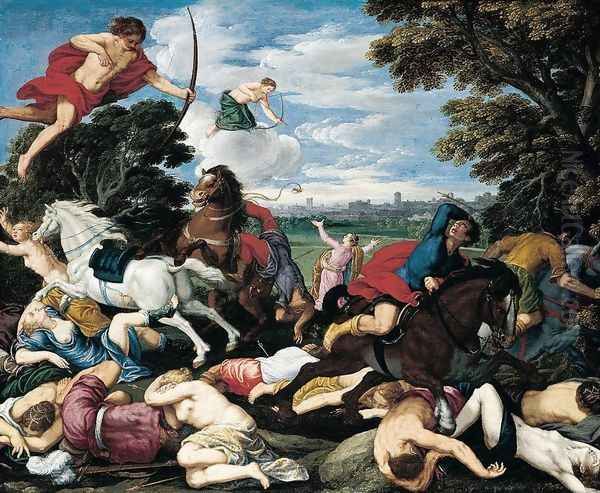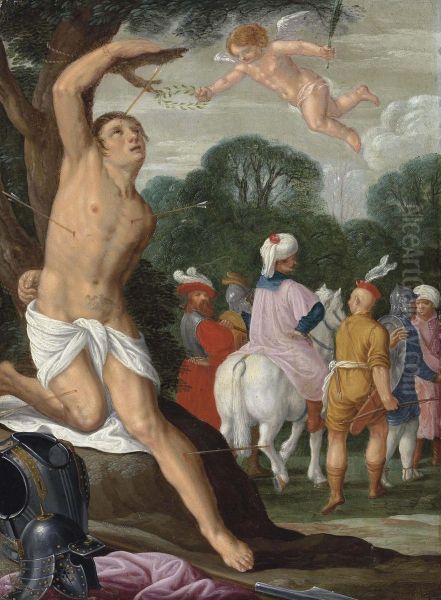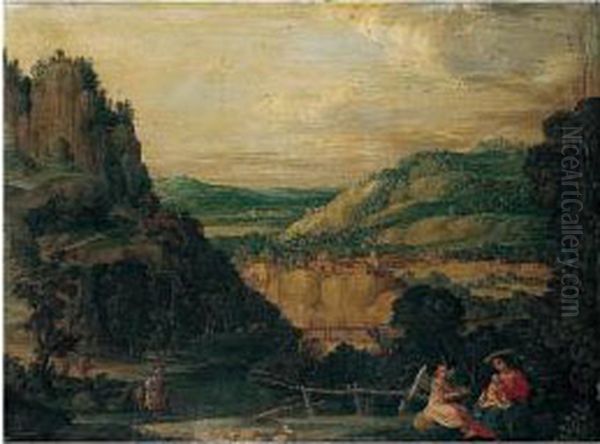Johann König (1586–1642) stands as a significant, if sometimes overlooked, figure in the landscape of early 17th-century German Baroque art. Born in Nuremberg and also passing away in his native city, König carved a distinct niche for himself, primarily celebrated for his exquisitely detailed small-scale paintings, often executed on copper. These "cabinet paintings" typically depicted historical, mythological, and biblical narratives, rendered with a finesse that appealed to the discerning collectors of his era. His artistic journey, particularly his formative years in Italy, imbued his work with a unique synthesis of Northern precision and Italianate luminosity and compositional dynamism.
Early Life and Formative Influences
While Nuremberg was his birthplace, evidence suggests that Johann König may have spent some time in Augsburg before his pivotal journey to Italy. His demonstrable knowledge and artistic inclinations hint at an early immersion in the rich artistic environment of Southern Germany. Augsburg, a prominent artistic and cultural hub, would have exposed him to a variety of influences, including the lingering traditions of the German Renaissance and the burgeoning interest in Italian art, often transmitted through prints and traveling artists.
The decision to travel to Italy was a common path for ambitious Northern European artists seeking to absorb firsthand the lessons of the Italian Renaissance and the exciting developments of the nascent Baroque. For König, this journey was transformative, shaping his style and thematic preoccupations for the remainder of his career.
The Roman Sojourn: Immersion in a Vibrant Artistic Milieu

Johann König is documented as arriving in Rome around 1610. The Eternal City at this time was a crucible of artistic innovation and a magnet for artists from across Europe. Here, König encountered a dazzling array of artistic styles and personalities. One of the most profound influences on his work was the German painter Adam Elsheimer, who, despite his own untimely death in Rome in 1610, had already established a powerful legacy. Elsheimer was renowned for his small, intensely poetic landscapes and biblical scenes on copper, characterized by innovative use of light and meticulous detail. König clearly absorbed Elsheimer's approach to small-format painting, his handling of light to create atmosphere, and his preference for copper as a support, which allowed for a smooth, jewel-like finish.
Beyond Elsheimer, König was exposed to the broader currents of Roman art. The revolutionary naturalism and dramatic chiaroscuro of Caravaggio were reshaping painting, and while König's style is more delicate, the heightened sense of drama and use of light in Baroque art generally would have been part of his Roman education. He also came into contact with the works of landscape specialists active in Rome, such as the Flemish painter Paul Bril. Bril’s idealized landscapes, often featuring classical ruins or biblical figures, provided a model for integrating figures within expansive, atmospheric settings.
Furthermore, the early works of Carlo Saraceni, an Italian painter who was himself influenced by both Caravaggio and Elsheimer, likely caught König's attention. Saraceni’s ability to blend Venetian colorism with Roman classicism and Caravaggesque drama offered another rich source of inspiration. The community of Northern artists in Rome, including figures like Pieter Lastman (later Rembrandt's teacher) and Cornelis van Poelenburgh, who also specialized in small, refined Italianate landscapes, would have provided a supportive and stimulating network for König.
Venetian Echoes and Florentine Touches
While his primary base in Italy was Rome, art historical analysis suggests that Johann König may have also visited Venice. The powerful influence of the Venetian school, with its emphasis on rich color, dynamic compositions, and atmospheric effects, is discernible in his work. A significant piece of evidence for this connection is his creation of a miniature copy of Paolo Veronese's monumental masterpiece, "The Marriage at Cana" (the original, dated 1563, now in the Louvre, Paris, measures an astounding 6.77 x 9.94 meters). König’s decision to replicate such an iconic Venetian work, albeit on a much smaller scale, underscores his admiration for Venetian High Renaissance painting and his desire to master its principles. The influence of other Venetian titans like Titian and Tintoretto would also have been part of the artistic air he breathed if he indeed spent time in La Serenissima.

Elements often associated with the Florentine school can also be traced in König's oeuvre, though these might have been absorbed through the cosmopolitan environment of Rome, where artists and artworks from various Italian centers converged. The clarity of design and graceful figural representation seen in some Florentine works could have complemented the influences he garnered from Roman and Venetian sources.
Return to Germany: An Established Master in Augsburg
Around 1614, Johann König returned to Germany, settling in Augsburg. This city, with its strong tradition of craftsmanship and patronage, provided a conducive environment for his talents. Soon after his return, he married, establishing personal and professional roots. His skills and Italian experience quickly gained recognition, and in 1622, he became a member of the painters' guild in Augsburg. His standing within the artistic community grew, and he eventually served as a leader within the guild, indicating the respect he commanded among his peers.
In Augsburg, König continued to produce his characteristic small-scale paintings on copper, which found favor with local patrons and collectors. He also likely engaged in other artistic activities, potentially including designs for larger decorative schemes or collaborations, as suggested by his later association with projects like the Alba Iulia fortress. His workshop may have also played a role in training younger artists, disseminating the Italianate style he had mastered.
Artistic Style, Themes, and Techniques
Johann König's artistic signature is defined by a meticulous technique, a vibrant palette, and a harmonious blending of German precision with Italianate warmth and compositional sophistication. His preference for painting on copper was crucial to his aesthetic. The smooth, non-absorbent surface of the metal allowed for exceptionally fine brushwork, luminous colors, and the rendering of minute details, giving his works a precious, jewel-like quality.
His subject matter was diverse, drawing heavily on biblical narratives, mythological tales, and historical events. These themes were popular in the Baroque era, offering opportunities for dramatic storytelling and the depiction of human emotion. König excelled at populating his scenes with numerous small figures, each carefully delineated and expressive, set within richly imagined landscapes or architectural settings.

His landscapes, whether as backdrops or as the primary subject, are particularly noteworthy. Influenced by Elsheimer and Bril, he created atmospheric vistas, often with a sense of depth and a subtle play of light. Works like "Extensive Landscape with the Flight into Egypt" (1620s) showcase his ability to integrate sacred narratives into expansive, naturalistic settings, where the landscape itself contributes significantly to the mood and meaning of the scene. Similarly, "Wooded River Landscape with the Baptism of St. John" demonstrates his skill in rendering lush foliage, reflective water, and a serene, pastoral atmosphere, all hallmarks of the idealized landscape tradition.
Representative Works: A Closer Look
Several works stand out as representative of Johann König's artistic achievements:
"The Death of Niobe": This mythological subject, depicting the tragic fate of Niobe whose children were slain by Apollo and Artemis as punishment for her hubris, allowed König to explore themes of divine retribution, maternal grief, and dynamic action. Such a scene would have been rendered with his characteristic attention to detail, capturing the emotional intensity of the figures within a carefully constructed composition.
"Extensive Landscape with the Flight into Egypt" (c. 1620s): This painting is a prime example of his landscape art. The Holy Family's journey is set within a panoramic vista, emphasizing their vulnerability but also the protective embrace of nature. The work would feature delicate rendering of trees, distant mountains, and atmospheric effects, showcasing the influence of Italian landscape painting. The specific dimensions of one version, 122 cm x 230 cm, suggest that while known for small cabinet pieces, he could also work on a somewhat larger, though still manageable, scale for specific commissions.
"Wooded River Landscape with the Baptism of St. John": Another example of a biblical scene integrated into a detailed landscape, this work would highlight König's ability to create a serene and spiritually resonant atmosphere. The lushness of the forest and the clarity of the river would be rendered with his typical finesse, drawing the viewer into the sacred event.
Copy of Veronese's "The Marriage at Cana": While not an original composition, König's miniature copy of this Venetian masterpiece is significant. It demonstrates his technical skill in translating a large-scale, complex work into a small format, and it underscores his deep engagement with Italian Renaissance art. Such copies were valued not just as reproductions but as demonstrations of an artist's virtuosity and understanding of the masters.
These works, typically executed on copper, exemplify his fusion of Northern European detail with Italianate composition and light. They were highly sought after by collectors for their intimate scale and exquisite craftsmanship.
Contemporaries, Collaborations, and Artistic Network

Johann König operated within a rich network of artistic exchange. His relationship with the works of Adam Elsheimer, Paul Bril, and Carlo Saraceni in Rome was foundational. He would also have been aware of other German artists who had made the Italian journey, such as Johann Rottenhammer, who also specialized in small mythological and religious scenes on copper and had worked in Venice and Rome before returning to Augsburg. Rottenhammer's success may have provided a model for König.
The influence of Flemish artists like Jan Brueghel the Elder, known for his own detailed small-scale landscapes and allegorical scenes, often on copper, also resonates with König's output. While direct contact is not always documented, the shared artistic concerns and stylistic similarities point to a broader European trend in cabinet painting.
Later in his career, there is evidence of König's involvement in larger, collaborative projects. For instance, he is mentioned in connection with the decoration of the Alba Iulia (Gyulafehérvár) fortress in Transylvania (modern-day Romania). Here, he is named alongside artists like Johann Vischer and Giuseppe Tencalla, who were involved in the sculptural decoration of the fortress gates, considered fine examples of early Baroque military architecture. König's role in such a project might have involved designs for painted elements or other decorative contributions, showcasing a different facet of his artistic practice beyond easel painting.
Family connections also played a role in the artistic world. Johann König was related to Johann Bretz, described as his "Schwager" (brother-in-law or cousin-in-law), who was also a painter. Such familial ties often facilitated artistic training, collaboration, and patronage.
Legacy and Art Historical Evaluation
Art historians position Johann König as an important exponent of German Baroque painting, particularly noted for his mastery of the cabinet painting on copper. He is recognized for successfully assimilating the lessons of Italian art, especially the innovations in light and landscape pioneered by artists like Elsheimer, and adapting them to a Northern European sensibility.
His works are praised for their technical brilliance, the vibrancy of their colors, and the charm of their detailed narratives. While he may not have achieved the revolutionary impact of a Caravaggio or a Rembrandt van Rijn, his contribution lies in the refinement and popularization of a particular genre of painting that was highly prized in the 17th century. His ability to create these small, precious objects of art catered to the tastes of an elite clientele who appreciated intricate craftsmanship and learned subject matter.
König's role as a guild leader in Augsburg also points to his significance within his local artistic community. He would have contributed to maintaining artistic standards and fostering the development of art in the city. His paintings, found in numerous European collections, continue to be admired for their beauty and skill, securing his place as a distinguished master of the German Baroque. His fusion of German and Italianate elements contributed to the rich tapestry of 17th-century European art, demonstrating the fruitful cross-cultural exchanges that characterized the period.
Conclusion
Johann König's career exemplifies the ambitions and achievements of a Northern artist who embraced the transformative power of Italian art while retaining a distinct personal and cultural identity. From his early training in Germany to his immersive experiences in Rome and potentially Venice, and his subsequent successful career in Augsburg, König consistently produced works of high quality and refined beauty. His small-scale paintings on copper, filled with intricate details, luminous colors, and engaging narratives, represent a significant contribution to the genre of cabinet painting and secure his legacy as a notable master of the German Baroque. His art serves as a testament to the vibrant artistic dialogues that transcended geographical borders in 17th-century Europe, enriching the continent's shared cultural heritage.